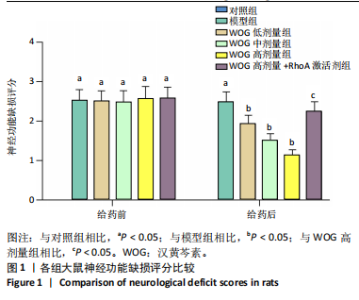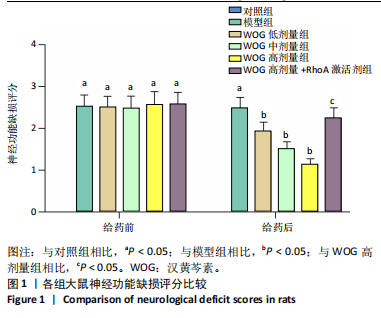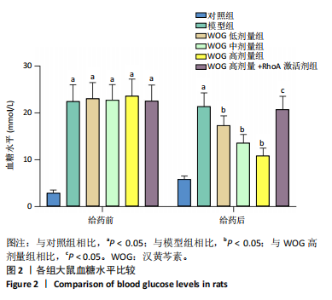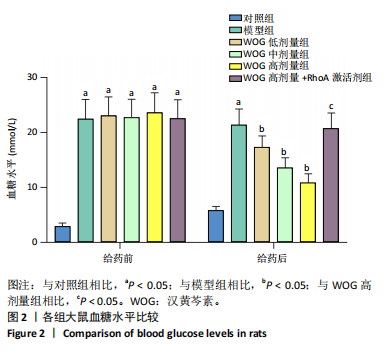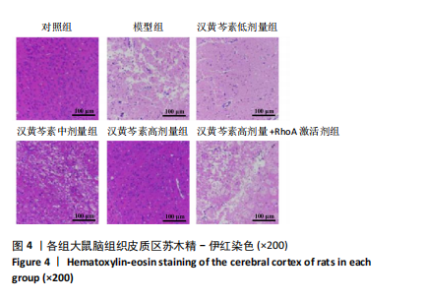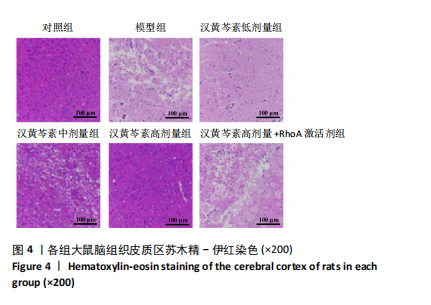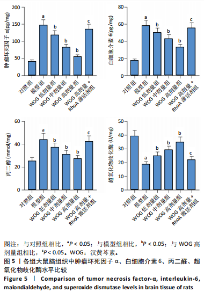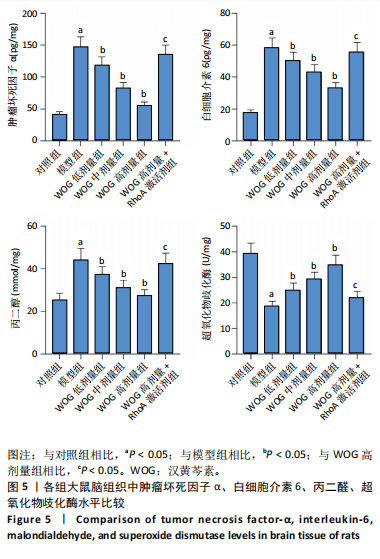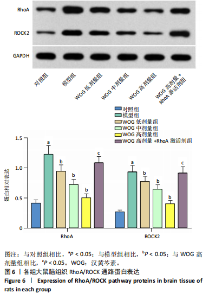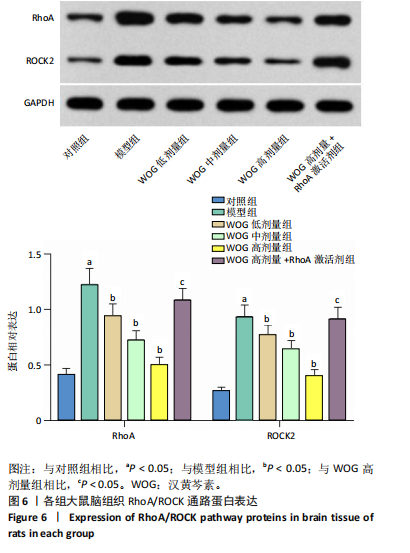Chinese Journal of Tissue Engineering Research ›› 2025, Vol. 29 ›› Issue (11): 2327-2333.doi: 10.12307/2025.349
Previous Articles Next Articles
Effect of wogonin on nerve injury in rats with diabetic cerebral infarction
Wang Huanhuan1, Liang Panpan1, Yang Jinshui1, Jia Shuxian2, Zhao Jiajia1, Chen Yuanyuan1, Xue Qian1, Song Aixia1
- 1Department of Neurology, 2Department of Geriatrics, Hebei North University Affiliated First Hospital, Zhangjiakou 075000, Hebei Province, China
-
Received:2024-03-28Accepted:2024-05-17Online:2025-04-18Published:2024-08-12 -
Contact:Song Aixia, Master’s supervisor, Chief physician, Department of Neurology, Hebei North University Affiliated First Hospital, Zhangjiakou 075000, Hebei Province, China -
About author:Wang Huanhuan, Master, Attending physician, Department of Neurology, Hebei North University Affiliated First Hospital, Zhangjiakou 075000, Hebei Province, China -
Supported by:the Medical Science Research Fund of Hebei Province, No. 20220584 (to WHH); Science and Technology Program Fund of Zhangjiakou City, No. 2121183D (to WHH)
CLC Number:
Cite this article
Wang Huanhuan, Liang Panpan, Yang Jinshui, Jia Shuxian, Zhao Jiajia, Chen Yuanyuan, Xue Qian, Song Aixia. Effect of wogonin on nerve injury in rats with diabetic cerebral infarction[J]. Chinese Journal of Tissue Engineering Research, 2025, 29(11): 2327-2333.
share this article
Add to citation manager EndNote|Reference Manager|ProCite|BibTeX|RefWorks
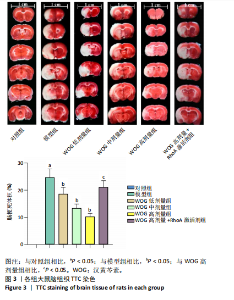
2.4 汉黄芩素对脑梗死体积的影响 与对照组相比,模型组大鼠脑梗死体积明显升高(P < 0.05);与模型组相比,汉黄芩素低、中、高剂量组脑梗死体积明显降低(P < 0.05);与汉黄芩素高剂量组相比,汉黄芩素高剂量+RhoA激活剂组脑梗死体积明显升高(P < 0.05),见图3。 2.5 汉黄芩素对脑组织皮质区病理变化的影响 对照组大鼠皮质区神经元排列整齐,细胞呈圆形,细胞质分布均匀,核膜清晰完整;模型组神经元结构严重受损,细胞坏死、变性、排列紊乱,细胞质萎缩,核固缩;汉黄芩素低、中、高剂量组神经元损伤改善,细胞变性和坏死减少;汉黄芩素高剂量+RhoA激活剂组神经元损伤加重,细胞变性增加,见图4。"
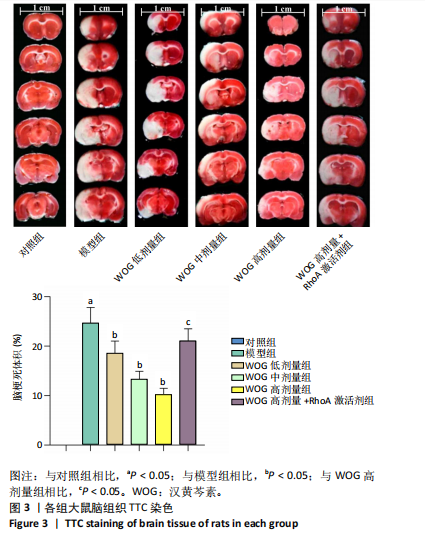
| [1] CLOETE L. Diabetes mellitus: an overview of the types, symptoms, complications and management. Nurs Stand. 2022;37(1):61-66. [2] MAIDA CD, DAIDONE M, PACINELLA G, et al. Diabetes and ischemic stroke: an old and new relationship an overview of the close interaction between these diseases. Int J Mol Sci. 2022;23(4):2397. [3] DENG D, QU Y, SUN L, et al. Fuyuan Xingnao Decoction Promotes Angiogenesis Through the Rab1/AT1R Pathway in Diabetes Mellitus Complicated With Cerebral Infarction. Front Pharmacol. 2021;12: 616165. [4] YANG WC, LI TT, WAN Q, et al. Molecular Hydrogen Mediates Neurorestorative Effects After Stroke in Diabetic Rats: the TLR4/NF-κB Inflammatory Pathway. J Neuroimmune Pharmacol. 2023;18(1-2):90-99. [5] FUSCO R, SCUTO M, CORDARO M, et al. N-palmitoylethanolamide-oxazoline protects against middle cerebral artery occlusion injury in diabetic rats by regulating the SIRT1 pathway. Int J Mol Sci. 2019; 20(19):4845. [6] PAN L, CHO KS, YI I, et al. Baicalein, baicalin, and wogonin: protective effects against ischemia-induced neurodegeneration in the brain and retina. Oxid Med Cell Longev. 2021;2021:8377362. [7] CHENG Z, TU J, WANG K, et al. Wogonin alleviates NLRP3 inflammasome activation after cerebral ischemia-reperfusion injury by regulating AMPK/SIRT1. Brain Res Bull. 2024;207:110886. [8] KHAN S. Wogonin and alleviation of hyperglycemia via inhibition of DAG mediated PKC expression. a brief insight. Protein Pept Lett. 2021;28(12):1365-1371. [9] KIMURA T, HORIKOSHI Y, KURIYAGAWA C, et al. Rho/ROCK Pathway and Noncoding RNAs: Implications in Ischemic Stroke and Spinal Cord Injury. Int J Mol Sci. 2021;22(21):11573. [10] WANG T, LI N, YUAN L, et al. MALAT1/miR-185-5p mediated high glucose-induced oxidative stress, mitochondrial injury and cardiomyocyte apoptosis via the RhoA/ROCK pathway. J Cell Mol Med. 2023;27(17):2495-2506. [11] ZHANG Y, MIAO L, PENG Q, et al. Parthenolide modulates cerebral ischemia-induced microglial polarization and alleviates neuroinflammatory injury via the RhoA/ROCK pathway. Phytomedicine. 2022;105:154373. [12] XIANG Q, LIU Y, CHEN L. Saikosaponin d (SSD) alleviates diabetic peripheral neuropathy by regulating the AQP1/RhoA/ROCK signaling in streptozotocin-induced diabetic rats. Acta Diabetol. 2023;60(6):805-815.
[13] LIU XQ, JIANG L, LI YY, et al. Wogonin protects glomerular podocytes by targeting Bcl-2-mediated autophagy and apoptosis in diabetic kidney disease. Acta Pharmacol Sin. 2022;43(1):96-110. [14] 张涛,毛治尉,豆倩云,等.基于RhoA/ROCK通路探讨赤芍总苷对心肌梗死大鼠心肌凋亡的影响[J].中国老年学杂志,2023,43(5): 1138-1142. [15] 吕小丽,仝宗兴.2型糖尿病合并缺血性脑卒中患者血糖波动情况及其影响因素[J].中国卫生工程学,2023,22(5):652-654. [16] HA J, CHOI DW, KIM KJ, et al. Pioglitazone use and reduced risk of dementia in patients with diabetes mellitus with a history of ischemic stroke. Neurology. 2023;100(17):e1799-e1811. [17] SU EJ, LAWRENCE DA. Diabetes and the treatment of ischemic stroke. J Diabetes Complications. 2022;36(11):108318. [18] BRUNING T, AL-KHALED M. Do statins reduce the mortality rate in stroke patients treated with systemic thrombolysis in a 5-year. Neural Regen Res. 2021;16(9):1807-1812. [19] TANG X, LIU L, MIAO Z, et al. Resolution of inflammation is disturbed in acute ischemic stroke with diabetes mellitus and rescued by resolvin D2 treatment. Free Radic Biol Med. 2022;188:194-205. [20] ZHU M, HE H, YU D, et al. Prediction of prognosis in patients with ischemic stroke combined with type 2 diabetes mellitus based on serum total bilirubin levels. Medicine (Baltimore). 2024;103(12):e37468. [21] JIN L, MO Y, YUE EL, et al. Ibrutinib ameliorates cerebral ischemia/reperfusion injury through autophagy activation and PI3K/Akt/mTOR signaling pathway in diabetic mice. Bioengineered. 2021;12(1):7432-7445. [22] XU Q, CHEUNG RTF. Melatonin mitigates type 1 diabetes-aggravated cerebral ischemia-reperfusion injury through anti-inflammatory and anti-apoptotic effects. Brain Behav. 2023;13(9):e3118. [23] 侯亚莉,林梅,梅稳,等.汉黄芩素对2型糖尿病小鼠糖尿病视网膜病变改善作用[J].中华中医药学刊,2019,37(10):2398-2400. [24] 张旭东,任桂灵,陈慧慧,等.汉黄芩素调控TLR4/MAPK/NF-κB信号通路对糖尿病肾病大鼠肾纤维化的影响[J].中国药理学通报, 2023,39(10):1840-1846. [25] ZHUANG J, PENG Y, GU C, et al. Wogonin accelerates hematoma clearance and improves neurological outcome via the PPAR-γ pathway after intracerebral hemorrhage. Transl Stroke Res. 2021;12(4):660-675. [26] 张乐国,朱翠敏,夏瑞雪,等.汉黄芩素调节Notch信号通路对脑缺血/再灌注模型小鼠神经细胞凋亡的影响[J].卒中与神经疾病, 2024,31(1):8-13. [27] 叶维,张红,王莉,等.汉黄芩素通过调控JNK/AP-1信号通路对缺血性脑卒中大鼠神经功能障碍、脑组织损伤的影响[J].中成药, 2023,45(10):3241-3246. [28] LEI L, ZHAO J, LIU XQ, et al. Wogonin alleviates kidney tubular epithelial injury in diabetic nephropathy by inhibiting PI3K/Akt/NF-κB signaling pathways. Drug Des Devel Ther. 2021;15:3131-3150. [29] SCHMIDT SI, BLAABJERG M, FREUDE K, et al. RhoA signaling in neurodegenerative diseases. Cells. 2022;11(9):1520. [30] KIMURA T, HORIKOSHI Y. MicroRNA-based targeting of the Rho/ROCK pathway in therapeutic strategies after spinal cord injury. Neural Regen Res. 2023;18(2):311-312. [31] CELLAI I, COMEGLIO P, FILIPPI S, et al. The regulatory effect of sex steroids on the RhoA/ROCK pathway in the rat distal vagina. J Sex Med. 2023;20(1):1-13. [32] LU W, CHEN Z, WEN J. The role of RhoA/ROCK pathway in the ischemic stroke-induced neuroinflammation. Biomed Pharmacother. 2023;165:115141. [33] YUAN Q, WANG FJ, JIA ZZ, et al. Xueshuantong injection combined with Salvianolate lyophilized injection improves the synaptic plasticity against focal cerebral ischemia/reperfusion injury in rats through PI3K/AKT/mTOR and RhoA/ROCK pathways. Brain Res. 2022;1787:147923. [34] HONG L, CHEN W, HE L, et al. Effect of Naoluoxintong on the NogoA/RhoA/ROCK pathway by down-regulating DNA methylation in MCAO rats. J Ethnopharmacol. 2021;281:114559. [35] LI N, ZHU QX, LI GZ, et al. Empagliflozin ameliorates diabetic cardiomyopathy probably via activating AMPK/PGC-1α and inhibiting the RhoA/ROCK pathway. World J Diabetes. 2023;14(12):1862-1876. [36] 蔡菲菲,王秀峰,周钱梅,等.黄芩素调节Rho-ROCK-MLC通路抑制乳腺癌细胞的生长与转移[J].天然产物研究与开发,2021,33(4): 570-576. [37] 孙吉凤,何海涛.黄芩素通过Ezrin相关信号转导通路对喉癌细胞迁移、侵袭的影响[J].中国老年学杂志,2021,41(12):2595-2598. [38] ZHANG Z, NONG L, CHEN M, et al. Baicalein suppresses vasculogenic mimicry through inhibiting RhoA/ROCK expression in lung cancer A549 cell line. Acta Biochim Biophys Sin (Shanghai). 2020;52(9):1007-1015. [39] YANG J, HAI Z, HOU L, et al. Baicalin attenuates panton-valentine leukocidin (PVL)-induced cytoskeleton rearrangement via regulating the RhoA/ROCK/LIMK and PI3K/AKT/GSK-3β pathways in bovine mammary epithelial cells. Int J Mol Sci. 2023;24(19):14520. [40] 沈艳玲, 承红,王世魁,等.黄芩苷通过ROS依赖性调节RhoA/ROCK通路保护氯化钴诱导心肌细胞损伤的实验研究[J].海南医学院学报,2024,30(7):481-488. [41] HOU B, QIANG G, ZHAO Y, et al. Salvianolic acid A protects against diabetic nephropathy through ameliorating glomerular endothelial dysfunction via inhibiting AGE-RAGE signaling. Cell Physiol Biochem. 2017;44(6):2378-2394. |
| [1] | Liu Zhezhe, Yu Meiqing, Wang Tingting, Zhang Min, Li Baiyan. Troxerutin modulates nuclear factor-kappaB signaling pathway to inhibit brain injury and neuronal apoptosis in cerebral infarction rats [J]. Chinese Journal of Tissue Engineering Research, 2025, 29(6): 1137-1143. |
| [2] | Zhao Xiaoxuan, Liu Shuaiyi, Li Qi, Xing Zheng, Li Qingwen, Chu Xiaolei. Different exercise modalities promote functional recovery after peripheral nerve injury [J]. Chinese Journal of Tissue Engineering Research, 2025, 29(6): 1248-1256. |
| [3] | Liu Zan, An Ran, Li Baocheng. Effect of pravastatin on functional recovery from sciatic nerve crush injury in rats [J]. Chinese Journal of Tissue Engineering Research, 2025, 29(5): 942-950. |
| [4] | Wang Yuru, Li Siyuan, Xu Ye, Zhang Yumeng, Liu Yang, Hao Huiqin. Effects of wogonin on joint inflammation in collagen-induced arthritis rats via the endoplasmic reticulum stress pathway [J]. Chinese Journal of Tissue Engineering Research, 2025, 29(5): 1026-1035. |
| [5] | Hu Chaoran, Cen Chaode, Yang Yang, Zhou Cheng, Huang Huaxian, Yuan Honghao, Luo Qin, Cao Yongfei. 3D printing assisted minimal invasive plate osteosynthesis versus intramedullary nail for treatment of AO12-C middle-proximal humeral fractures [J]. Chinese Journal of Tissue Engineering Research, 2025, 29(33): 7116-7122. |
| [6] | Zhao Xiaoxuan, Liu Shuaiyi, Xing Zheng, Li Qingwen, Chu Xiaolei, Li Qi. Research hotspots and trends in application of tissue engineering in peripheral nerve injury [J]. Chinese Journal of Tissue Engineering Research, 2025, 29(30): 6591-6600. |
| [7] | Chen Zhen, Chen Xi, Li Xiaoting, Chen Daxin, Hong Weiwu. Comparison of medial-lateral and lateral-only fixation for pediatric supracondylar humeral fractures: a systematic review and meta-analysis [J]. Chinese Journal of Tissue Engineering Research, 2025, 29(27): 5924-5932. |
| [8] | Zhang Shuyang, Du Xinyu, Zhao Donglin, Xing Zheng, Chu Xiaolei, Li Qi. Application of virtual reality technology in functional recovery of peripheral nerve injury [J]. Chinese Journal of Tissue Engineering Research, 2025, 29(21): 4593-4601. |
| [9] | Zheng Jiachen, Yang Entong, Zhu Yizhou, Liu Fang. Adult stem cells from different germ layers applied in peripheral nerve injury repair [J]. Chinese Journal of Tissue Engineering Research, 2025, 29(19): 4102-4110. |
| [10] | Liu Minqi, Gao Mingwei, Chu Xiaolei, Xing Zheng, Li Shihao, Ding Ning, Li Yajie, Li Qi . Different frequencies of electrical stimulation promote recovery from peripheral nerve injury [J]. Chinese Journal of Tissue Engineering Research, 2025, 29(14): 3061-3069. |
| [11] | Lyu Lijie, Yuan Yiming, Wang Yan, , Pei Fei, . Relationship between ferroptosis and peripheral nerve injury [J]. Chinese Journal of Tissue Engineering Research, 2025, 29(14): 3020-3026. |
| [12] | Feng Ruiqin, Han Na, Zhang Meng, Gu Xinyi, Zhang Fengshi. Combination of 1% platelet-rich plasma and bone marrow mesenchymal stem cells improves the recovery of peripheral nerve injury [J]. Chinese Journal of Tissue Engineering Research, 2024, 28(7): 985-992. |
| [13] | Wang Yueguang, Mu Xiaohong, Jiang Shengyuan, Deng Bowen, Kang Ximei, Su Jianguang. Correlation between early serum markers and AISA grading in patients with acute spinal cord injury [J]. Chinese Journal of Tissue Engineering Research, 2024, 28(34): 5494-5499. |
| [14] | Ma Jianglei, Zhang Huijie, Zhang Chenfang, Yang Xitong, Cheng Jianjie, Wang Guangming. Neuroprotective mechanism by which fenofibrate regulates superoxide dismutase 2 expression in transgenic C57BL/6J mice [J]. Chinese Journal of Tissue Engineering Research, 2024, 28(28): 4547-4552. |
| [15] | Duan Kunling, Fei Jing, Li Leiji. Autophagy protects neurons against facial nerve injury in rats [J]. Chinese Journal of Tissue Engineering Research, 2024, 28(27): 4378-4382. |
| Viewed | ||||||
|
Full text |
|
|||||
|
Abstract |
|
|||||
